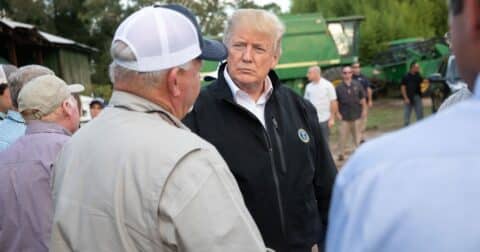News
Sentient Impact Report 2025
Policy•1 min read
Explainer
We know he loves meat — but what does his policy history reveal?


Words by Seth Millstein
Agriculture policy may not be the most high-profile political issue, but it’s an immensely important one that significantly shapes millions of lives — human and animal alike. During his presidency, Donald Trump’s actions on agriculture, animal welfare and factory farming were a stark departure from that of his predecessor, and could be a hint of things to come if Trump wins a second term in November. Let’s take a look at what we could expect from a second Trump presidency when it comes to these issues.
In recent weeks, Trump has begun saying that he wants to “make America healthy again.” He appears to have gotten this slogan from former presidential candidate Robert F. Kennedy Jr., who recently suspended his campaign and endorsed Trump. Kennedy speaks a lot about improving Americans’ diets and health, and Trump has recently started using some of the same language, pledging to “make America healthy again” and “get toxic chemicals out of our environment [and] our food supply” at a recent rally in Pennsylvania.
As many observers have noted, however, this is more or less the opposite of what Trump actually did during his presidency. In addition to reversing a ban on chlorpyrifos, a pesticide that can be fatal to humans, Trump’s deregulation of factory farms made it more difficult to track toxic pollutants in the air and water supply, and his USDA moved to let schools reduce the amount of fruits and vegetables served to students at lunch.
When it comes to implementing and changing the country’s agricultural policies, presidents have a number of tools at their disposal.
They can, of course, sign or veto bills sent to them by Congress. A president can also signal to Congress which legislation they’d like to see on their desk — and if the president’s party also controls the House of Representatives and the Senate, such signaling might actually be effective.
Perhaps more significantly, the president has significant latitude when it comes to shaping and implementing federal regulations. Much of this has to do with how they manage the various agencies under their control, says Andrew deCoriolis, executive director of the nonprofit Farm Forward.
“Federal agencies, and the way in which the agencies operate — how they interpret their own regulatory mandates, [and] how they choose to be more or less aggressive towards certain industries” all fall under the president’s purview, deCoriolis tells Sentient.
This element of the equation is particularly significant in the meat and agriculture industries, as both are subject to significant — though not necessarily comprehensive — regulations.
As we’ll see, Trump had a significant impact on U.S. agriculture policy, and he used all of the above tools to do so.
Trump struck a pro-business, anti-regulation stance toward agriculture and meat producers during his time in the Oval Office, and took many actions to assist those industries — sometimes, in the case of the COVID-19 pandemic, at the expense of the general public.
In general, Trump’s actions as president also indicated a lack of concern for animal welfare. However, there are a couple of significant exceptions to this that are worth highlighting.
First, Trump signed a Farm Bill in 2018 that outlawed the slaughter of dogs and cats for human consumption — something that, incredibly, was only illegal in six states prior to that bill’s signing. That bill also reauthorized a program that provides federal assistance not only to victims of domestic violence, but also to their companion animals, as they transition out of abusive relationships.
The next year, Trump signed the Preventing Animal Cruelty and Torture Act (PACT). This law strengthened existing laws against animal cruelty by closing a loophole that made it difficult to prosecute acts of animal cruelty that took place on federal land and in federal facilities.
To be clear, Trump didn’t vocally champion either of these policies, and the PACT Act was so uncontroversial that it passed unanimously in the Senate. Nevertheless, the former president could have plausibly killed either initiative if he’d so desired, and he didn’t.
But again, these were the exceptions. Most of what the Trump administration did in the agricultural realm did not improve the lives of animals, and instead empowered factory farmers and agribusiness interests.
During his 2016 campaign, Trump did receive some donations from some major players in the agriculture industry. But it would be wrong to blame these donors for Trump’s pro-agribusiness stance, simply because these donations, in the grand scheme of things, were relatively small.
According to data from OpenSecrets, Trump received around $4.5 million in agribusiness money during the 2016 cycle. That’s not nothing, but it’s also not exactly eye-popping either, and amounted to a relatively small share of Trump’s total haul from donors that year. By contrast, Sen. Marco Rubio received almost $7 million in agribusiness donations during that same cycle — and he didn’t even make it out of the Republican primary.
That said, Trump has received almost $10 million in agribusiness donations this cycle, more than twice as much as in 2016. If nothing else, this does suggest that the industry was pleased — or at least not displeased — with his actions the last time he was president.
Food in the U.S. must be produced in accordance with specific standards in order to be labeled “organic,” and the USDA is responsible for writing and enforcing these standards. At the very end of his second term, President Obama finalized a sweeping update to the organic standards for livestock that, while far from perfect or comprehensive, would significantly improve the welfare of farmed animals.
Under Trump, however, the USDA withdrew this rule — which was over 10 years in the making and had garnered overwhelming public support during its public comment period — before it could be implemented. This meant that the previous rules, which have been widely criticized for their vague language surrounding animal welfare standards, remained in place.
Ultimately, President Biden reversed Trump’s decision and implemented the new livestock standards; as such, Trump’s move to withdraw the rules amounted to little more than a three year delay. It’s also worth noting that, while the new rules were generally lauded by animal rights activists, they contained some significant loopholes and still allowed for certain gruesome farming practices, like the debeaking of chickens, to continue on organic farms.
One could argue, however, that this makes Trump’s decision even more damning than it otherwise would have been, as it indicated that even a modest improvement in animal welfare was unpalatable to his administration.
Concentrated Animal Feeding Operations (CAFOs), more commonly known as factory farms, release massive amounts of greenhouse gasses into the air. This exacerbates global warming and, in many cases, sickens people in nearby communities.
There are several federal laws that, in theory, would require CAFOs to track their greenhouse gas emissions and report them to the federal government. This would be the first step to eventually empowering the government to regulate greenhouse gas emissions from factory farms.
However, thanks to a series of legal loopholes, the largest factory farms are exempt from these reporting requirements. This is largely due to several actions taken by the Trump administration.
In 2018, Trump signed a law that exempted factory farms from the Comprehensive Environmental Response, Compensation and Liability Act (CERCLA), a decades-old law that requires businesses to notify federal emergency response agencies when they spill, leak or otherwise accidentally discharge hazardous waste.
The next year, Trump’s EPA adopted a rule that exempted factory farms from the Emergency Planning and Community Right-to-Know Act (EPCRA), which is similar to CERCLA but covers state and local emergency agencies instead.
In the early days of the COVID-19 outbreak, businesses involved in food preparation came under heightened scrutiny due to the highly contagious nature of the disease and the centrality of food in American life.
Three months into the pandemic, Trump signed an executive order compelling meatpacking plants to stay open amidst the outbreak, despite mounting public health concerns. Citing the Defense Production Act, it ordered the Secretary of Agriculture to “take all appropriate action under that [act] to ensure that meat and poultry processors continue operations” during the pandemic, even when some state and local governments were taking measures to close those plants.
It was later revealed that the meat industry had been vigorously lobbying the Trump administration to enact such an order in the weeks before Trump issued it. The North American Meat Institute (NAMI), a trade group, had drafted a hypothetical executive order on meatpacking plants and sent it to the administration a week before Trump issued the order. Certain parts of the final order mirrored the language in NAMI’s proposal.
Two weeks before signing the executive order, he announced the formation of an advisory committee to guide efforts on reopening the economy in the wake of the pandemic. Its members included several meat industry CEOs, such as Ronald Cameron, a wealthy Republican donor and chair of the fourth-largest poultry producer in the country.
DeCoriolis cites Cameron’s appointment as a key development in the administration’s COVID response — and the subsequent consequences of that response.
“The Trump administration elevating a meat executive to a position of influence in its COVID response had huge effects on workers, primarily in slaughterhouses, many of whom got sick and died because of their exposure at work,” deCoriolis says.
In the final tally, at least 59,000 workers at meatpacking plants contracted COVID in the first year of the pandemic, 269 of whom died. A subsequent congressional investigation later found that the president and CEO of NAMI had praised the USDA for “representing our industry’s interests” in the weeks leading to the executive order.
The day he took office, Trump suspended all proposed regulations that hadn’t yet been finalized or published, which included withdrawing a rule that would have ended the painful procedure of horse soring. However, the courts later determined that this decision was unlawful, and the rule was eventually implemented under Biden.
In 2019, Trump’s USDA came under fire again after a damning Washington Post report about the agency’s threadbare enforcement of animal welfare laws. In one particularly controversial incident, Trump’s Secretary of Agriculture reportedly blocked the agency’s own inspectors from rescuing hundreds of heat-distressed raccoons they’d discovered in a metal shed in Iowa.
In 2020, Trump’s Department of the Interior issued a rule that allows a variety of controversial hunting practices in Alaska’s national reserves, such as shooting hibernating black bears in their dens and hunting swimming caribou from motor boats.
It’s worth keeping in mind that the past actions of an elected official aren’t always a perfect indicator of what they’ll do in the future; plenty of politicians have changed, or “evolved,” their stances on various issues over time, and Trump is certainly one of them.
At the same time, Trump’s history of policies on agriculture and factory farms strongly suggests that, if elected to a second term, he would be much more of an ally to agribusiness and factory farmers than to animals, consumers or the environment.